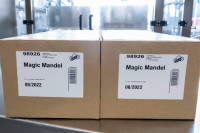When it comes to labelling its products, the northern German ice cream manufacturer Eisbär Eis relies on solutions from Weber Marking Systems. These work particularly reliably and are highly appreciated by the employees.
Your freezer should always have the perfect popsicles for when the mood strikes: Small ice pralines for snacks, large popsicles for dessert and big ice cream buckets that can be spooned while relaxing on the couch. Eisbär Produktions GmbH, located in Plummendorf between Rostock and Stralsund/Germany, offers exactly this broad variety. Systems made by Weber Marking Systems GmbH from Rheinbreitbach near Bonn/Germany brave the freezing cold production environment to reliably label the products.
“Ice cream is made with sugar, skim milk, whey and flavours,” explains Martin Esch, Eisbär GmbH CTO. “After cooking and ripening, the products are quality-tested before being frozen at minus 40 degrees Celsius.” This is how Eisbär GmbH, working round the clock in three shifts, churns out up to three million servings of ice cream a day. The company’s portfolio features 250 different products. Every year, 60 new ones join the fold.
The customer base of the company, which was founded in 1992, quickly expanded from regional clients to food retailers all over Germany and then all over Europe. In Plummendorf, the company now makes more than 18 million litres of ice cream a year. Despite its expansion, Eisbär remains family-run – just like its supplier for marking technology: several machines made by Weber Marking Systems mark Eisbär products at various stages along the production process.
“When I joined Eisbär in 2013, there were already several systems made by Weber Marking Systems,” Martin Esch recounts. “The machines do a very reliable job, and employees really appreciate them. When we grew our product range, it made sense to look at Weber Marking Systems’ portfolio.” In addition to several inkjet printers that mark product packaging, several Weber machines also label Eisbär’s outer packaging and pallets.
The best-by date and batch and lot numbers need to be included on the different types of ice-cream packaging. At Eisbär, a Linx 8920 continuous inkjet printer takes care of that. It is capable of printing more than 2,000 characters a second. Printing can be divided into a maximum of four lines. The printer boasts easy control and outstanding reliability in addition to its high speed. The 10” touchscreen offers intuitive control of the printing system. Self-explanatory icons guide users through the process of changing settings and print data.
The Linx 8920 continuously monitors ink and solvent levels to ensure production safety. A sensor in the print head permanently tracks ink viscosity and automatically adjusts it when required. A red or green background on the screen shows whether a required coding speed is being met or missed.
The system automatically flushes its printer nozzles with solvent when switched on or off, slashing the frequency of print head cleaning. Maintenance is also easy. On average, ink and filters have to be replaced every two years. This is announced in advance so that it can be taken care of during production pauses. No technicians are needed for the thirty-minute procedure.
After the products have been labelled, a packing machine sorts the units into external packaging. “We pack external boxes according to customer wishes. We are very flexible,” Martin Esch says. To prevent mix-ups, the boxes are then immediately labelled: Weber Marking Systems’ Legi-Air 4050E labelling system provides every box with information about the contents and customer with the help of a Novexx DPM-print module and a swivel applicator that can swivel at full 90°.
The system has rotation applicators and swivel arms to place labels on the front of the outer boxes. The freshly printed label is fed onto the dispensing stamp and held there by suction. Triggered by a signal, the arm swivels and applies the label to the front of the product whizzing by – no contact required and no need to stop the belt. When the label has been blown onto the packaging, the arm retracts to let the next box zoom closer.
Coming from various production and packaging lines, the labelled cartons head to the central palletizing station in a jumbled order. The palletizing station works in chilly – 6 to –10 °C. That is why the Legi-Air 4050P pallet labeller is protected by air-conditioned casing.
When a freshly wrapped pallet approaches, the label printer applicator prints the information coming from the ERP system onto a pallet label and shifts the label onto the dispenser stamp. When the pallet is in position, the casing’s pneumatic window opens to let out the applicator. It extends, labels the pallet on its front as it passes by, and immediately retracts. While the pallet trundles on, the print module pushes another label onto the dispenser stamp. The applicator again extends, labels the pallet on the side, and then zips back into the casing. While the sliding window closes, the pallet ambles along to the high-bay warehouse.
Martin Esch sums up: “For us, there is no reason not to continue to work with Weber Marking Systems. The service is good, we’ve actually never had any problems with the equipment – and if there were any problems, help was provided quickly”.





